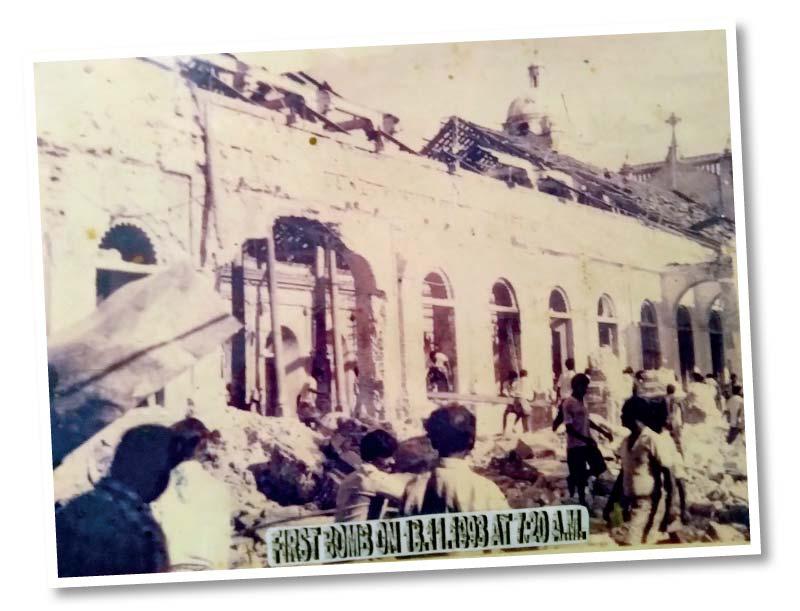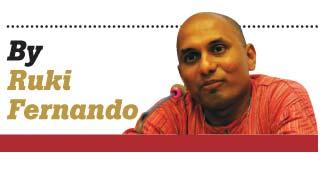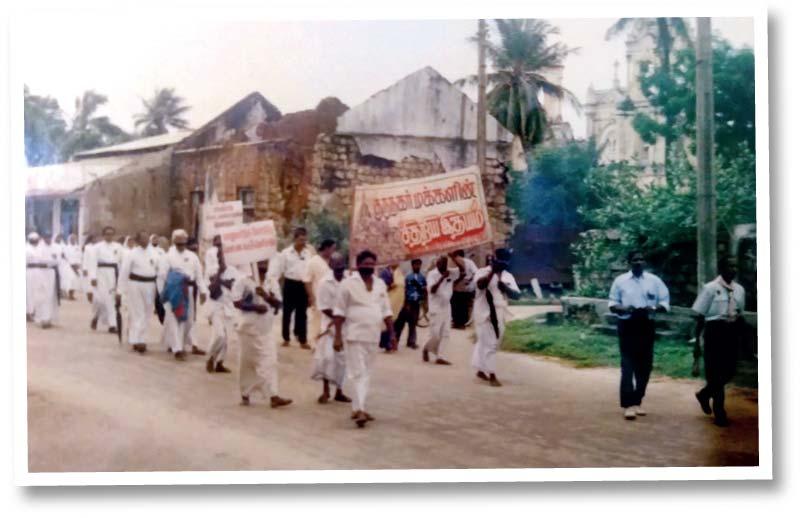11 Nov 2023 - {{hitsCtrl.values.hits}}

On Saturday 13th November 1993, around 7.20am, two bombs were dropped from an Air Force plane over St. James Catholic Church in Gurunagar, Jaffna. Nine civilians were killed, several others injured and church and buildings nearby suffered severe damages. That morning, the holy mass was celebrated at a nearby smaller church and not at St. James, otherwise, many more would have been killed and injured.
 Some of those in the church were those who had come to pray and others had come there out of fear of bombings by Sri Lankan Air Force planes hovering in the Jaffna skies that morning, thinking the church will provide them a safe space. But it was not to be.
Some of those in the church were those who had come to pray and others had come there out of fear of bombings by Sri Lankan Air Force planes hovering in the Jaffna skies that morning, thinking the church will provide them a safe space. But it was not to be.
One eyewitness, who was a Deacon (about to be ordained as a Catholic priest) recalled being in the parish priest’s residence at the time of the incident. He had heard and seen a plane fly overhead a few times, left the residence and sought shelter near the water tank, and was also injured in the leg. The cook at the church had been with the Deacon and rushed to the church seeking refuge from bombing and was amongst those killed. The Chief Catechist (Sunday school teacher) of the church was also killed. One lady’s body was blown to pieces and all that was seen and collected had been flesh. At least one child has been amongst those killed. A letter signed by the Parish Priest and the Secretary of the Parish Committee said that two persons were “roasted alive” and others were “crushed by the debris”. One lady was identified by her jewellery and a handkerchief which had Rs. 35 given by her husband before she had left home. Limbs and flesh of those killed were strewn all over and these remains and those who perished under the debris were buried in one coffin. One survivor spoke about the trauma, saying he had dreams about the bombing for many days and he had to seek counselling. The metal tabernacle and sacred hosts were also strewn about. The roof, beams and walls of the church had collapsed. The priest’s residence, the church assembly hall and nearby buildings were also damaged. The force of the bombs was such that a big, heavy door hinge was found on top of a tree.
Origins of Catholics in Gurunagar dates back about 400 years to 1624 and St. James church is one of the oldest churches in Jaffna, reported to have been built in 1861. It is also one of the largest churches in Jaffna at that time in 1993 and would have been easily identifiable as a church from above. The letter from the Parish Priest and the Parish Secretary had noted that there were no militant’s camps anywhere near the vicinity. The letter also said that Sri Lankan government had repeatedly asked people to take refuge in churches and temples and then, it’s armed forces proceed to bomb and kill people inside these buildings.
Before and after the church bombing
A series of bombing have been reported before and after the church bombing. The previous day, 12th November 1993, the Jaffna District Secretariat (also known as the Kachcheri) was bombed and the District Secretary (also known as the Government Agent or GA) was also injured. On the evening of the same day of the church bombing, the Nanthavil Amman Hindu Temple at Kokuvil had been bombed and on the next day, 14th November 1993, the Vairavar Hindu Temple at Varany had been bombed. The latter temple was completely destroyed. Several persons had been injured and several houses nearby had also been damaged. Bombs were also dropped within 50 metres of the Jaffna General Hospital entrance, situated within the Hospital high security zone, on 14th November 1993, the day after the church bombing. Hospitals in Killinochchi and Mulliawalai had been bombed on 15th November 1993.
A silent protest march was held by local people on 3rd December 1993, starting from the church to the office of the International Committee of the Red Cross (ICRC) and District Secretariat. One participant recalled that some protesters had covered their mouths in black cloths and carried banners. Areas nearby the church was again subjected to aerial bombing on the evening of the day the protest was held, leading to deaths of at least 8 civilians, injuries to many others and damages to shops. One church leader said that a shell had fallen in his house on the evening of 3rd December after the protest.
“Gnanartha Pradeepaya” and “Messenger”, the Sinhalese and English weekly papers published by the Catholic Archdiocese of Colombo carried news about this on 5th December 1993. Both papers reported that the Secretary of the Ministry of Defence had said this was an unfortunate missing of a target, but the Catholic Bishop of Jaffna had written to the then President D. B. Wijethunga, saying the government must accept full responsibility of this bombing. I could not find any reports of the Catholic Bishops Conference of Sri Lanka taking up this matter with the government or commenting on it.
The church community had come together to rebuild the church, forming the “St. James Church Reconstruction Board”. The Catholic Bishop of Jaffna had also been involved. Some notes of meetings and correspondence have been retained. The war and tensions in Jaffna at that time, the embargo imposed by the Sri Lanka government which had included construction materials, had made rebuilding the church very difficult. Permission of the Government Agent had to be sought even to bring sand. There has been multiple correspondence between church leaders to the President, the Ministry of Reconstruction, Rehabilitation and Social Welfare, the Resettlement and Rehabilitation Authority of the North (RRAN) and the Government Agent of Jaffna, from 1993 till at least 2002. By 14th February 2000, repairs to the main wing of the church had been done, including erection of poles, beams, repairs to the roof and walls, through contributions of parish people and benefactors amounting to Rs. 3,286,240. Parishioners had also contributed cement, sand and other building materials. According to church communications, the Jaffna Engineers Department had estimated Rs.9,078,000 to repair the church on 6th February 1994, but by 12th January 2002, only Rs.2,350,000 had been provided by the state, including the military.

Justice and memorials
The church repairs have been completed now. According to elderly parishioners, the church retains the same size, design etc. In a plaque listing “Landmarks of Gurunagar Parish” from it’s origins in 1624 to 2013, the “Aerial attack on the church – 9 victims” in 1993 is noted. The plaque also notes the 1986 massacre of 31 Gurunagar fishermen at sea (media reports and local people accusing the Navy) and 1995 exodus from Jaffna. A memorial is erected at the place one of the bombs had fallen at the church, with words “Honour for the Dead, Warning to the Living, Temple for Justice”. A quote from the bible “They shall raise up the former devastations….for I the Lord love justice” is also etched on the roof above this memorial. Annual memorial is held at this place every year on 13th November and this year too, a remembrance service is being planned 30 years after the tragedy.
To my knowledge, this was first major attack on a Church during the war. This was followed by several other such attacks on churches, such as Navaly and Allaipiddy churches in Jaffna district and Madhu and Pesalai churches in Mannar district.
The death certificates issued indicates the cause of death as “aerial bombing”. The children of one mother who was killed had received Rs. 10,000 each, but not much information was available about compensation to those dead and injured. It should not be too difficult to trace who was in the Air Force flight which dropped the two bombs on the church, who gave orders etc. While at the church, I asked whether there had been any investigations and efforts to hold those responsible accountable. Both men from whom I had asked this laughed in my face. It seems clear there has been no investigations, no prosecutions, no convictions, despite the ample evidence and acceptance that the Air Force was responsible for the carnage. It is very late, but still not too late for meaningful acknowledgement, apology, compensation and holding those reasonable legally accountable.
Sources: St. James church archives, media reports from 1993, testimonies of survivors, eyewitnesses, families of victims, Catholic priests and church workers

26 Dec 2024 23 minute ago
26 Dec 2024 29 minute ago
26 Dec 2024 1 hours ago
26 Dec 2024 2 hours ago
26 Dec 2024 4 hours ago